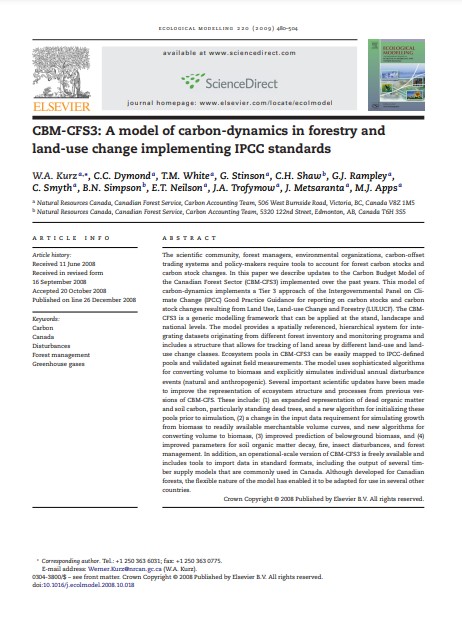CBM-CFS3: A model of carbon-dynamics in forestry and land-use change implementing IPCC standards
Bosque Modelo:
Red Internacional de Bosques Modelo
Temática:
Cambio climático
Tipo de documento:
Artículo científico
Resumen
The scientific community, forest managers, environmental organizations, carbon-offset trading systems and policy-makers require tools to account for forest carbon stocks and carbon stock changes. In this paper we describe updates to the Carbon Budget Model of the Canadian Forest Sector (CBM-CFS3) implemented over the past years. This model of carbon-dynamics implements a Tier 3 approach of the Intergovernmental Panel on Climate Change (IPCC) Good Practice Guidance for reporting on carbon stocks and carbon stock changes resulting from Land Use, Land-use Change and Forestry (LULUCF). The CBMCFS3 is a generic modelling framework that can be applied at the stand, landscape and national levels. The model provides a spatially referenced, hierarchical system for integrating datasets originating from different forest inventory and monitoring programs and includes a structure that allows for tracking of land areas by different land-use and landuse change classes. Ecosystem pools in CBM-CFS3 can be easily mapped to IPCC-defined pools and validated against field measurements. The model uses sophisticated algorithms for converting volume to biomass and explicitly simulates individual annual disturbance events (natural and anthropogenic). Several important scientific updates have been made to improve the representation of ecosystem structure and processes from previous versions of CBM-CFS. These include: (1) an expanded representation of dead organic matter and soil carbon, particularly standing dead trees, and a new algorithm for initializing these pools prior to simulation, (2) a change in the input data requirement for simulating growth from biomass to readily available merchantable volume curves, and new algorithms for converting volume to biomass, (3) improved prediction of belowground biomass, and (4) improved parameters for soil organic matter decay, fire, insect disturbances, and forest management. In addition, an operational-scale version of CBM-CFS3 is freely available and includes tools to import data in standard formats, including the output of several timber supply models that are commonly used in Canada. Although developed for Canadian forests, the flexible nature of the model has enabled it to be adapted for use in several other countries.
Información Bibliográfica
Autor:
Kurz, W.A., Dymond, C.C., White, T.M., Stinson, G., Shaw, C.H., Rampley, G.J., Smyth, C., Simpson, B.N., Neilson, E.T., Trofymow, J.A., Metsaranta, J. & Apps, M.J.
Revista:
Ecological Modelling
Año:
2009
N°:
4
País :
Canadá
Páginas:
480 - 504
Volumen:
220
Idioma:
Ingles
Palabras claves
Carbon Canada Disturbances Forest management Greenhouse gases





